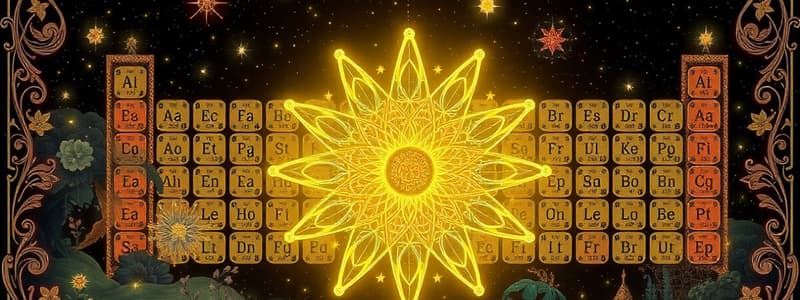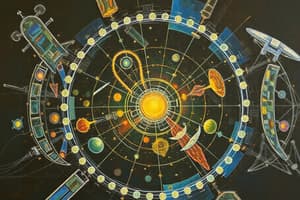Podcast
Questions and Answers
What is the term used to describe the number of protons in an atom?
What is the term used to describe the number of protons in an atom?
- Isotope number
- Atomic mass
- Element category
- Atomic number (correct)
Which type of bond is formed when electrons are transferred from one atom to another?
Which type of bond is formed when electrons are transferred from one atom to another?
- Covalent bond
- Hydrogen bond
- Metallic bond
- Ionic bond (correct)
In the Periodic Table, elements are arranged in rows called:
In the Periodic Table, elements are arranged in rows called:
- Columns
- Groups
- Families
- Periods (correct)
What is the expected outcome of a synthesis reaction?
What is the expected outcome of a synthesis reaction?
Which of the following best describes isotopes?
Which of the following best describes isotopes?
Match the following subatomic particles with their characteristics:
Match the following subatomic particles with their characteristics:
Match the following atomic properties with their definitions:
Match the following atomic properties with their definitions:
Match the following types of chemical bonds with their descriptions:
Match the following types of chemical bonds with their descriptions:
Match the following Periodic Table terms with their meanings:
Match the following Periodic Table terms with their meanings:
Match the following types of chemical reactions with their examples:
Match the following types of chemical reactions with their examples:
Flashcards
Atomic Structure
Atomic Structure
The basic building block of all matter, composed of protons, neutrons, and electrons.
Periodic Table Groups
Periodic Table Groups
Vertical columns on the Periodic Table with similar chemical properties.
Covalent Bond
Covalent Bond
A bond formed by sharing electrons between atoms.
Chemical Equation Balancing
Chemical Equation Balancing
Signup and view all the flashcards
Types of Chemical Reactions
Types of Chemical Reactions
Signup and view all the flashcards
Protons, Neutrons, and Electrons
Protons, Neutrons, and Electrons
Signup and view all the flashcards
Atomic Number
Atomic Number
Signup and view all the flashcards
Isotopes
Isotopes
Signup and view all the flashcards
Ionic Bond Formation
Ionic Bond Formation
Signup and view all the flashcards
Study Notes
Atomic Structure
- Atoms are composed of protons, neutrons, and electrons.
- Protons carry a positive charge, electrons a negative charge, and neutrons are neutral.
- Protons and neutrons reside in the atom's nucleus, while electrons orbit the nucleus.
Atomic Number, Mass, and Isotopes
- Atomic number represents the number of protons in an atom.
- Atomic mass refers to the average mass of an atom, considering isotopes.
- Isotopes are atoms of the same element with different numbers of neutrons.
The Periodic Table
- The periodic table organizes elements based on their atomic number and properties.
- Elements are arranged in groups (vertical columns) and periods (horizontal rows).
- Groups share similar chemical properties due to a similar number of valence electrons.
- Periods show trends in atomic size and electronegativity.
Element Properties and Categories
- Elements are classified as metals, nonmetals, or metalloids based on their properties.
- Electronegativity measures an element's ability to attract electrons in a chemical bond.
- Atomic radius increases down a group and decreases across a period.
Chemical Bonding
- Ionic bonds form between a metal and a nonmetal through the transfer of electrons.
- Covalent bonds form between nonmetals through the sharing of electrons.
- Metallic bonds form between metal atoms by sharing a "sea" of delocalized electrons.
Predicting Bond Types
- Bond types can be predicted based on the types of elements involved in the reaction.
Chemical Equations
- Chemical equations represent chemical reactions.
- Chemical equations are balanced to maintain conservation of mass.
Types of Chemical Reactions
- Synthesis reactions combine two or more substances to form a more complex one.
- Decomposition reactions break down a complex substance to simpler ones.
- Other types of reactions exist, such as single-displacement/replacement, double-displacement/replacement, and combustion reactions.
Studying That Suits You
Use AI to generate personalized quizzes and flashcards to suit your learning preferences.




